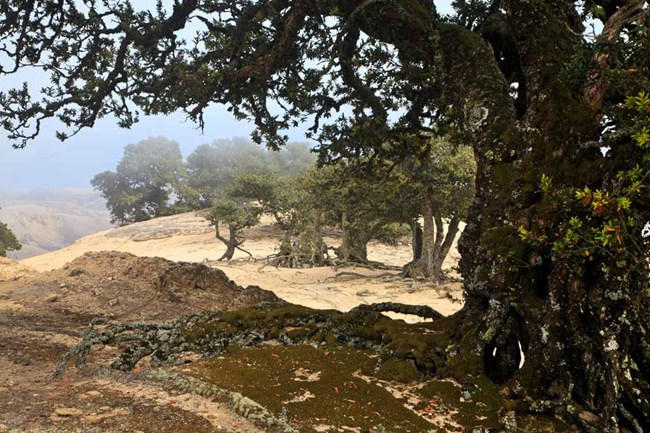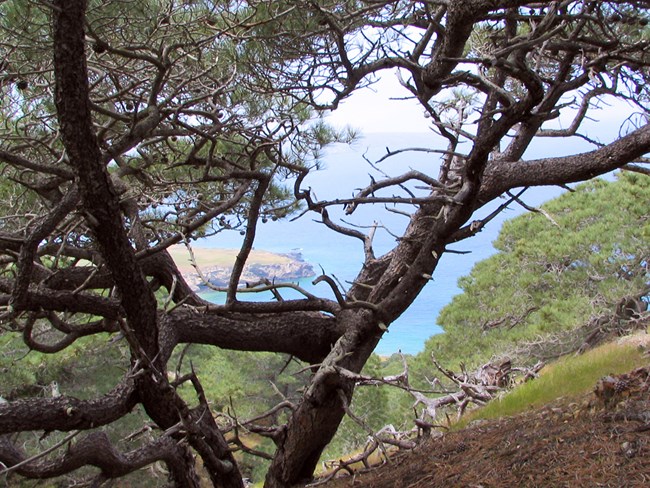
Oak Woodlands Oak woodlands on the Channel Islands are dominated by either coast live oak (Quercus agrifolia) or island oak (Quercus tomentella) trees. On Santa Cruz Island, coast live oak dominates the coastal oak woodland community which may be found on north-facing slopes and in shaded canyons on the isthmus and in a small area on the east end of the island. On the slopes, the more common understory species include toyon, wood mint, creeping snowberry, and poison oak. In the canyon bottoms, common understory species include honeysuckle, manroot, blackberry, milkmaids, and climbing penstemon. Santa Cruz Island Scrub-jays prefer these woodlands, or scrub oak-dominated chaparral, for building nests and raising their young, and their large bills are specially designed for eating the oak trees’ acorns. Groves of island oaks are found on Soledad Peak and Black Mountain on Santa Rosa Island. Heavy grazing in years past, and now erosion have prevented new island oak seedlings from establishing in these groves, although the Black Mountain grove is recovered enough that new seedlings are growing around it. Small oak woodlands can also be found in the deep, moist canyons on the north-facing slopes of West Anacapa Island.Pine Woodlands Two types of pine woodlands are found on Santa Cruz and Santa Rosa islands; Bishop pine and Torrey pine. Bishop Pine Woodlands On Santa Cruz Island, large areas of Bishop pine woodland are found on north-facing slopes in the upper reaches of Cañada Christy, near Pelican Bay, and south of China Harbor. Smaller stands of Bishop pine are found in the upper portion of Canada de los Sauces, on Sierra Blanca ridge, and on the south side near China Harbor. On Santa Rosa Island, the Bishop pine groves are smaller and in poor condition, although there has been some recent recruitment and establishment of seedlings and juvenile plants. Other trees that are occasionally interspersed within the Bishop pine community include: island ironwood (Lynothamnus floribundus ssp. aspleniifolius), coast live oak (Quercus agrifolia), and island oak (Q. tomentella). The Bishop pine community also includes many commonly associated understory species such as chamise, coyote brush, globe lantern, toyon, smooth mouse ears, island deerweed, island monkeyflower, chaparral current, poison oak, canyon sunflower, and the rare island barberry. On Santa Rosa Island, manzanita is another common understory species. Bishop pines, like some of the Channel Islands’ chaparral species, are adapted to coexist with fire. Mature trees may succumb to a blaze, but the cones they produce typically remain closed until fire opens them and disperses their seeds, allowing stands to quickly regenerate. Cones can sometimes open without fire on a particularly hot day or after a long wait.
NPS Torrey Pine Woodlands Santa Rosa Island Torrey pine (Pinus torreyana ssp. insularis) is one of two subspecies of Torrey pines. The other (P. t. ssp. torreyana) grows on the mainland north of San Diego. They are extremely rare, and may be the rarest pine species in the world. Santa Rosa Island Torrey pine is confined to two groves on the northeast side of the Santa Rosa Island. The groves are expanding, with many seedlings growing successfully around their perimeters in recent years. Within the larger grove, Torrey pine occurs in single-species stands but mixes with island chaparral in some areas. Underneath the dense overstory, there is a thick duff layer occasionally occupied by annual plants like chickweed, common sow thistle, and ripgut brome. Perennial understory species include June grass, San Diego needlegrass, and chaparral zigadene. Where Torrey pine and island chaparral mix, the overstory is more open and the pines are mixed with woody shrubs such as toyon, island cherry, lemonade berry, and island manzanita.Ironwood Woodlands Single-species stands of island ironwood (Lynothamnus floribundus ssp. aspleniifolius) can be found on Santa Rosa and Santa Cruz islands. Ironwood woodlands occur mostly on rocky slopes or ridge-tops with well-drained, gravelly soils.Mixed Woodlands Mixed woodlands can be found on Santa Cruz Island on north-facing slopes, ravines, and canyons, particularly at higher elevations. Dominant canopy or overstory species can vary from a mixture of species unique to the Channel Islands to pure stands of oak (Quercus spp.) or ironwood (Lyonothamnus floribundus). Other dominant species include toyon (Heteromeles arbutifolia) and island cherry (Prunus ilicifolia ssp. lyonii). The oak species found in mixed woodlands are canyon live oak (Quercus agrifolia), Macdonald’s oak (Quercus macdonaldii) and island oak (Quercus tomentella). This community mixes with island chaparral on dry, rocky slopes while turning into grasslands on the deeper soils of the plateaus and more gentle slopes. Understory species include bent grass, coyote-brush , bedstraw, wild-cucumber, island monkeyflower, lemonade berry, death camas, and California polypody. |
Last updated: March 10, 2021
